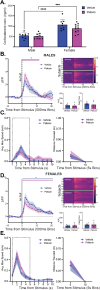Increased reactivity of the paraventricular nucleus of the hypothalamus and decreased threat responding in male rats following psilocin administration
- PMID: 38909051
- PMCID: PMC11193716
- DOI: 10.1038/s41467-024-49741-9
Increased reactivity of the paraventricular nucleus of the hypothalamus and decreased threat responding in male rats following psilocin administration
Abstract
Psychedelics have experienced renewed interest following positive clinical effects, however the neurobiological mechanisms underlying effects remain unclear. The paraventricular nucleus of the hypothalamus (PVN) plays an integral role in stress response, autonomic function, social behavior, and other affective processes. We investigated the effect of psilocin, the psychoactive metabolite of psilocybin, on PVN reactivity in Sprague Dawley rats. Psilocin increased stimulus-independent PVN activity as measured by c-Fos expression in male and female rats. Psilocin increased PVN reactivity to an aversive air-puff stimulus in males but not females. Reactivity was restored at 2- and 7-days post-injection with no group differences. Additionally, prior psilocin injection did not affect PVN reactivity following acute restraint stress. Experimental groups sub-classified by baseline threat responding indicate that increased male PVN reactivity is driven by active threat responders. These findings identify the PVN as a significant site of psychedelic drug action with implications for threat responding behavior.
© 2024. The Author(s).
Conflict of interest statement
Authors have no competing interests to report.
Figures









References
MeSH terms
Substances
Grants and funding
- P60 AA011605/AA/NIAAA NIH HHS/United States
- AA026858/U.S. Department of Health & Human Services | NIH | National Institute on Alcohol Abuse and Alcoholism (NIAAA)
- GM135095/U.S. Department of Health & Human Services | NIH | National Institute of General Medical Sciences (NIGMS)
- R01 AA026858/AA/NIAAA NIH HHS/United States
- R01 AA028782/AA/NIAAA NIH HHS/United States
LinkOut - more resources
Full Text Sources

